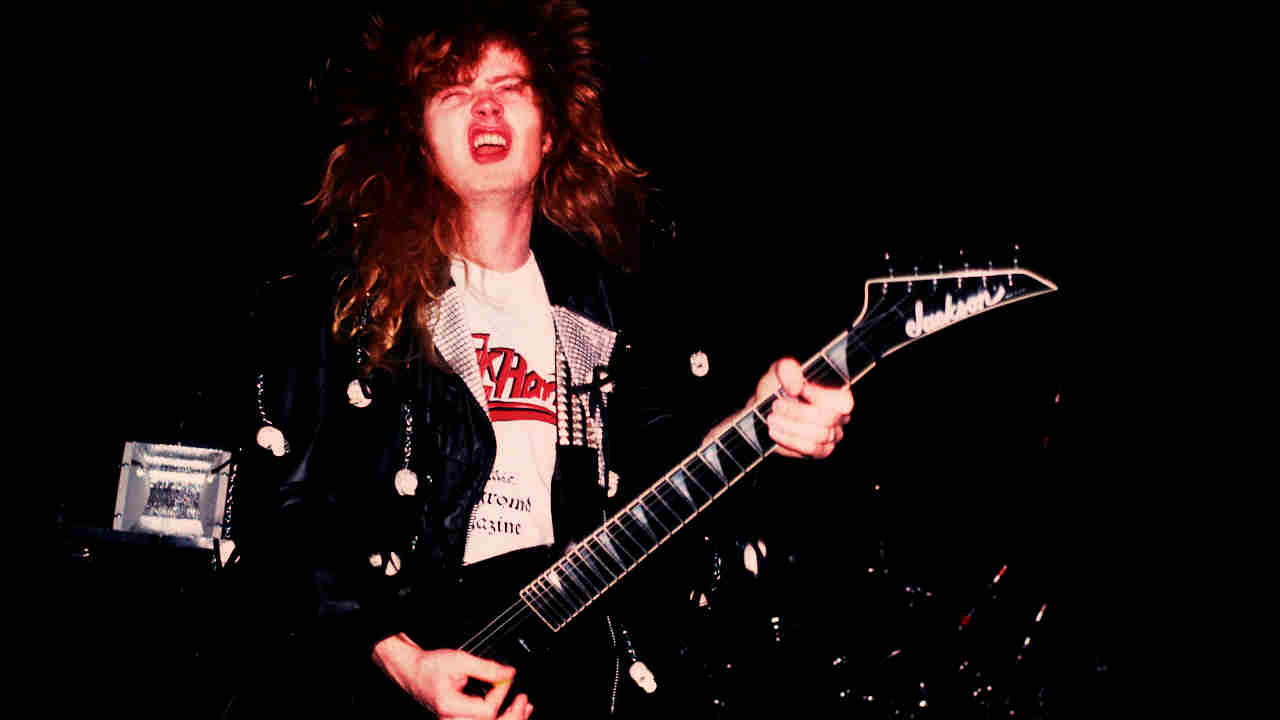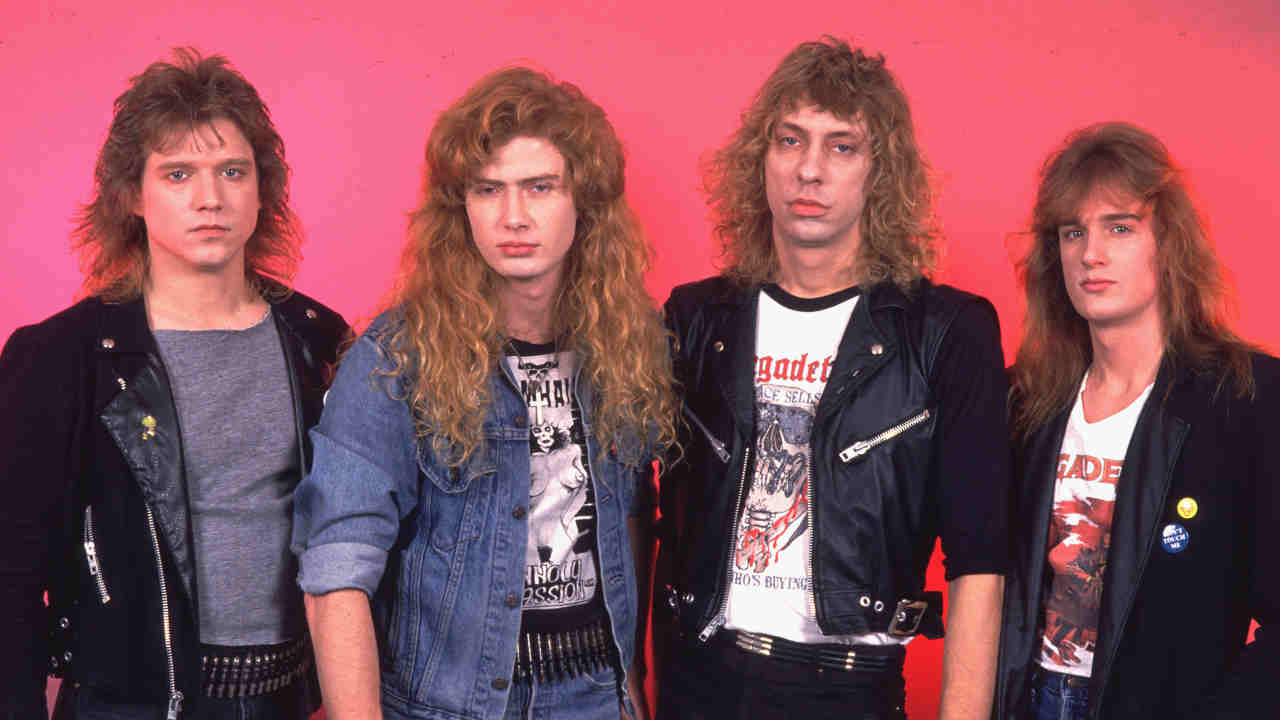Megadeth’s debut album, 1985’s Killing Is My Business… And Business Is Good, was recorded on a budget of $8000, and it sounded like it. That record crackled with energy and spite - it was leader Dave Mustaine’s personal fuck-you to his former bandmates in Metallica, who had kicked him out of the band a couple of years earlier for partying too hard.
Killing Is My Business… had been a good start, but it would be their second album, Peace Sells… But Who’s Buying?, that elevated Megadeth to thrash metal’s top tier. And in the song Peace Sells itself, they delivered one of the cornerstone songs of the era – one that showed Megadeth were way more than just the band fronted by the guy that got thrown out of Metallica.
Megadeth existed in a state of perpetual chaos during the early years of their existence. Mustaine’s partying had only increased since putting the band together, and his drug intake had gotten more hardcore with it. Guitarist Chris Poland and drummer Gar Samuelson were a couple of jazz-loving musos who had moved to California from New York and brought their heroin habits with them. Mustaine and original Megadeth bassist David Ellefson, who were no strangers to booze and coke, soon jumped onboard that train.
“It was very hard,” Ellefson told Classic Rock in 2017 of the band’s lifestyle at that point. “Any money we should have saved for food or paying rent immediately went up our noses or on cigarettes or burgers. Peace Sells… Buy Who’s Buying? was the heroin, cigarettes and hamburgers album.”
Heroin may have sunk its claws into Megadeth, but the fog wasn’t so thick that it completely clouded their ambition. The band moved into a dank rehearsal room in Vernon, an industrial area south of LA’s downtown. They’d kitted out the room with egg crates and built a loft so they could crash there.
“On any given day, either me or Dave was homeless,” recalled Ellefson. “And so it became a party place – we could invite girls down, we could hang out. It was the place to hang. But it was also a very lonely, dark, bleak existence if you ever had to stay there. You’d pass out hearing other bands rehearsing all night.”
Despite their living circumstances, there was a momentum to Megadeth as they entered Music Grinder Studio with producer Randy Burns in March 1986 to record their second album. The band’s new label, Capitol, stumped up $25,000 to make the album – triple the advance for Killing Is My Business. “It was like: ‘Wow, this is a real record deal,” Ellefson remembers. “We’ve got enough to make a good-sounding record. There’s even a couple of bucks to pay some bills and survive.’”
It’s a mark of Mustaine’s drive that the songs that appeared on Peace Sells… But Who’s Buying? were already in the bag long before Megadeth entered he studio, despite the band’s seat-of-their-pants existence.

“We were out on tour constantly, playing Killing Is My Business… and writing Peace Sells… But Who’s Buying? as we went along,” Mustaine told Classic Rock in 2017. “It would have been nice to have sat down and been in a house in the hills: ‘Hey, let's write some songs!’ But we were bouncing around in vans and motorhomes, trying to survive.”
Mustaine and Ellefson were actually in the house of Killing Is My Business producer Karat Faye when the seeds of the title track were sewn. Ellefson had brought along a BC Rich Eagle bass that he had ripped the frets out of. Suddenly, Mustaine picked up the instrument and started playing the rolling bass line that would become Peace Sells instantly recognisable intro.
“It was like, ‘Whoah, that sounds really cool,’” recalled Ellefson. “That same day, we were driving over to Vernon to pick up Gar. I was driving and Dave always sat in the shotgun seat, and Dave looks over at me and said: ‘What do you think of ‘Peace Sells But Who’s Buying?’ I was, like: ‘Wow, that’s cool.’”
The pair got to their rehearsal space with Samuelson and Chris Poland in tow and instantly began fleshing out the track. “That song fell out on the rehearsal room floor in about two hours,” recalled Ellefson. In its nascent form, Peace Sells stretched on for eight sprawling minutes. It was the experienced Samuelson - one of the few people Mustaine deferred to musically – who insisted they hack it back to four minutes.
“That was not a typical groove for Megadeth. It almost felt too simple in a way. I'm surprised, especially with the level of musicianship of Chris and Gar, who were very progressive fusion musicians, that we could keep it that simple. It really was an exercise in discipline for us.”
The lyric that gave the album its full title had been rattling around Mustaine’s brain for a while. He’d been staying over at casual girlfriend’s place when he saw copy of Reader’s Digest magazine on her nightstand, which featured an interview with Patti Smith. Something Smith said in the article instantly grabbed Mustaine’s attention: “Peace sells, but nobody’s buying it.”
“I went, ‘Oh god, I gotta write a song about that,’” Mustaine told MSN Music. “So I changed the words around a little bit, but I had no paper so I took a pen and wrote the lyrics on the wall of the rehearsal building we were living in.”
Lyrically, its jaundiced view of government and religion dispensed with metal’s swords-’n’-sorcery approach in favour of a more realistic world view. When Mustaine sang: ‘What do you mean, I don’t support your system? I go to court when I have to,’ he meant it. This was an underdog rooting for his fellow underdogs.
“I wrote it because I was tired of people mocking metal in general and mocking people who are metal fans,” Mustaine told Rolling Stone. “It was hard for me to watch the way we were stereotyped on TV, just as dumbasses. For the most part, I think that a lot of musicians are very intelligent and very talented. It's a bummer the way people had been stereotyped.”
In terms of velocity, Peace Sells barely qualified as a thrash song. Still, the riff that powered it remains one of Mustaine’s finest moments, while the kicker came towards the end of the song, when it picked up the pace. ‘Peace sells, but who’s buying?’ sang Mustaine, delivering the mantra-like line with cynicism in his voice and a sneer nailed onto his face.
Megadeth made a video for Peace Sells – a rarity for a thrash band in 1986 – which cut clips of the band playing live into a disorientating rush of stroboscopic images taken from contemporary news footage. MTV picked up on it, instantly elevating the band’s profile. The channel also used the opening bassline as the intro for their news channel. “But they did it minus one note so I wouldn’t get paid for it for years,” Mustaine complained to Rolling Stone.
Despite Megadeth’s narcotic lifestyle and constant money struggles, Peace Sells and its parent album served notice that the band were genuine contenders, and their leader was far from the permanently wasted fuck-up his reputation suggested. Increasingly poisonous personality differences between Mustaine and guitarist Poland and drummer Samuleson resulted in the latter pair being fired soon after the Peace Sells… But Who’s Buying? campaign, but the singer and David Ellefson were in it for the long haul.
“Dave and I were in a position where there was no Plan B,” Ellefson told Classic Rock. “There was no escape hatch. There was no, 'If this doesn't work we'll go do that.’ That backs-against-the-wall commitment is what drove us to make Peace Sells.”

